Una copia de seguridad completa del sitio es una de las mejores defensas contra cualquier tipo de amenaza a la seguridad de su sitio web.
Copias de seguridad regulares son una cosa que cada propietario del sitio debe tener. En el pasado, le mostramos cómo mantener su contenido seguro con BackupBuddy y cómo crear manualmente copias de seguridad de la base de datos de WordPress.
Sin embargo, lo mejor de WordPress es que dispone de múltiples opciones para hacer cualquier cosa.
En este tutorial, le mostraremos cómo crear una copia de seguridad de WordPress de forma gratuita utilizando BackWPup.
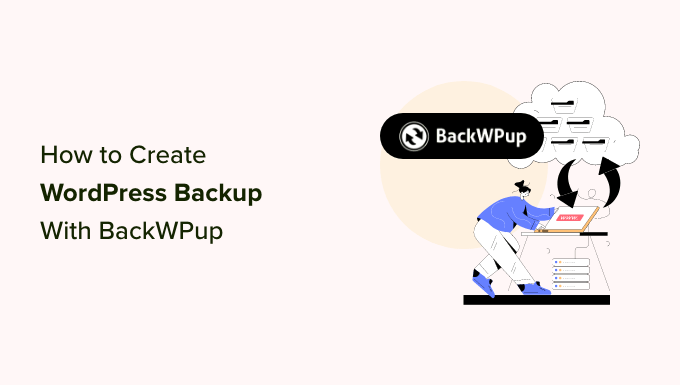
¿Por qué crear una copia de seguridad de WordPress?
Todos los propietarios de sitios web deben crear copias de seguridad periódicas de sus sitios web para asegurarse de que sus datos permanecen seguros en caso de accidente.
Hay varias cosas que pueden afectar a los datos de tu sitio web, por ejemplo:
- Malware para sitios web que inyecta código malintencionado en su sitio web.
- Ransomware que bloquea los datos de su sitio web.
- Borrado accidental de archivos o datos importantes del sitio web debido a un error humano o del servidor.
Puede que piense que su empresa de alojamiento de WordPress ofrece copias de seguridad periódicas.
Sin embargo, según nuestra experiencia, esas copias de seguridad no son fiables. ¿Qué ocurre si la empresa de alojamiento pierde sus datos? ¿O qué pasa si suspenden tu cuenta por alguna razón y se niegan a devolverte tus datos?
Por este motivo, debe crear siempre sus propias copias de seguridad de WordPress.
Hay varias maneras de automatizar todo el proceso de copia de seguridad utilizando uno de estos excelentes plugins de copia de seguridad de WordPress.
Nota: Las copias de seguridad de BackWPup solo pueden restaurarse manualmente. Es por eso que recomendamos el uso de Duplicator, que es la mejor solución de copia de seguridad de WordPress y es bien conocido por las características de restauración y migración de sitios fiables.
Dicho esto, vamos a ver cómo crear fácilmente una copia de seguridad de WordPress utilizando BackWPup
Creación de copias de seguridad de WordPress con BackWPup
Para este tutorial, usaremos BackWPup para crear una copia de seguridad gratuita de WordPress.
Primero, necesitas instalar y activar el plugin BackWPup. Para más detalles, consulte nuestro tutorial sobre cómo instalar un plugin de WordPress.
Paso 1: Crear un trabajo de copia de seguridad
Al activar el plugin, necesita visitar la página BackWPUP ” Añadir nuevo trabajo. Un trabajo en BackWPup es un conjunto de instrucciones que usted proporciona al plugin acerca de la copia de seguridad que desea hacer.
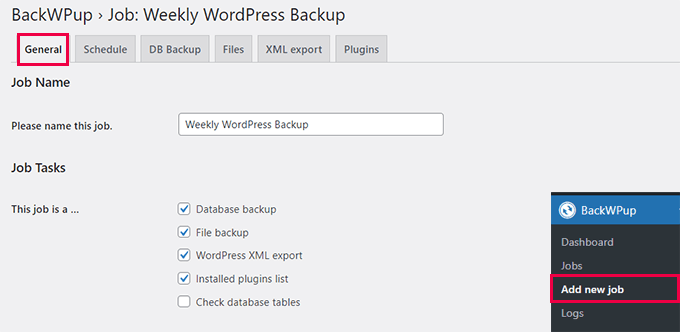
En primer lugar, proporcione un nombre para su trabajo. Puede ser cualquier cosa que le ayude a recordar lo que hace esta copia de seguridad. En nuestro ejemplo, estamos usando “Copia de seguridad semanal de WordPress”.
A continuación, seleccione las tareas que desea que realice esta copia de seguridad. Le recomendamos que marque / compruebe todas las opciones.
Desplázate un poco hacia abajo hasta la sección “Destino del trabajo”. Aquí es donde puede seleccionar dónde desea almacenar la copia de seguridad.
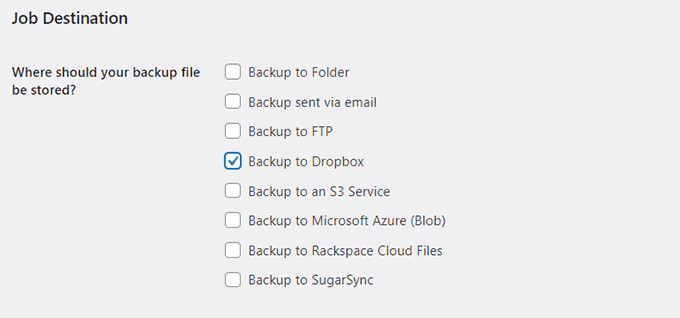
Puede almacenar archivos de copia de seguridad en su servidor, enviarlos por correo electrónico, hacer copias de seguridad en FTP y subirlos a Dropbox, Amazon S3, Windows Azure, Rackspace y SugarSync.
Haga lo que haga, NO guarde las copias de seguridad en su servidor. Esto anula el propósito de crear la copia de seguridad, que es tener una copia de seguridad de su sitio web guardada en otro lugar.
Para este tutorial, utilizaremos Dropbox.
Al elegir una opción se añadirá una nueva pestaña al menú Trabajo.
Importante: No olvides hacer clic en el botón “Guardar cambios” para guardar tus ajustes.
Ahora, cambie a la nueva pestaña con el nombre del destino donde desea almacenar su copia de seguridad. Por ejemplo, si eliges Dropbox, entonces verás una pestaña titulada ‘A: Dropbox’.
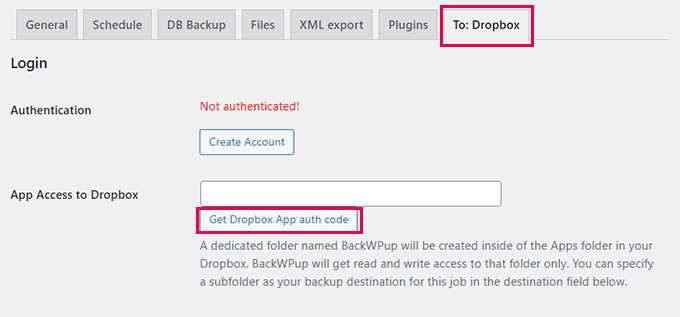
Desde aquí, puedes establecer los ajustes de tu cuenta en la nube. Por ejemplo, si has seleccionado Dropbox, solo tienes que hacer clic en el botón “Get Dropbox App auth code” para establecer los ajustes. A continuación, se te indicará que permitas el acceso de la aplicación a tu cuenta de Dropbox y que establezcas una carpeta para tus copias de seguridad.
Después, haz clic en el botón “Guardar cambios” para guardar tus ajustes.
Paso 2: Programar la copia de seguridad
A continuación, debe cambiar a la pestaña Programación. En la opción “Iniciar trabajo”, elija la opción “con WordPress cron”.
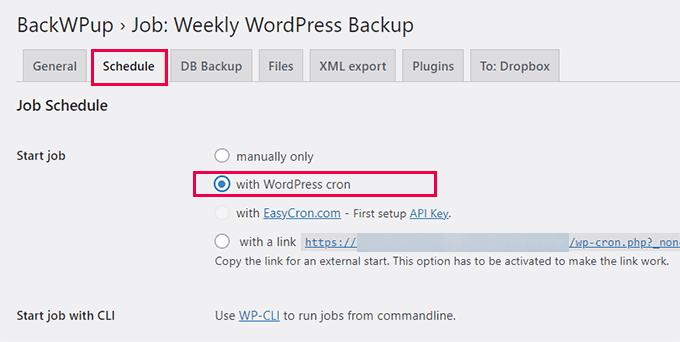
WordPress cron es el sistema integrado de WordPress que se utiliza para ejecutar tareas programadas.
Ahora, desplázate un poco hacia abajo y elige la frecuencia de tu trabajo de copia de seguridad. Le recomendamos que elija una frecuencia semanal o mensual, dependiendo de la frecuencia con la que actualice el contenido de su sitio web.
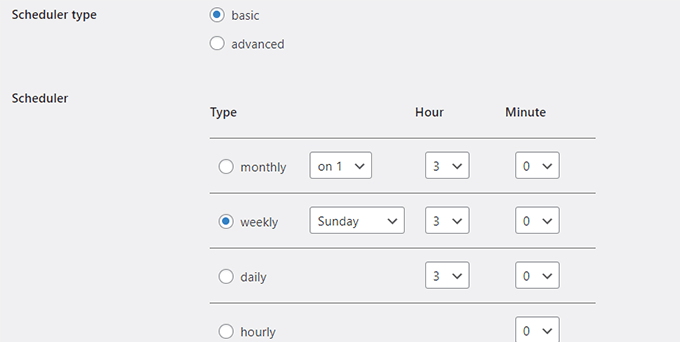
A continuación, haz clic en el botón “Guardar cambios” para establecer los ajustes.
Paso 3: Seleccionar qué incluir en la copia de seguridad
Ahora, debe elegir lo que desea incluir o excluir de la copia de seguridad.
Cambie a la pestaña “Copia de seguridad de base de datos” y seleccione las tablas que desea incluir en la copia de seguridad. Si no está seguro, seleccione todas las tablas.
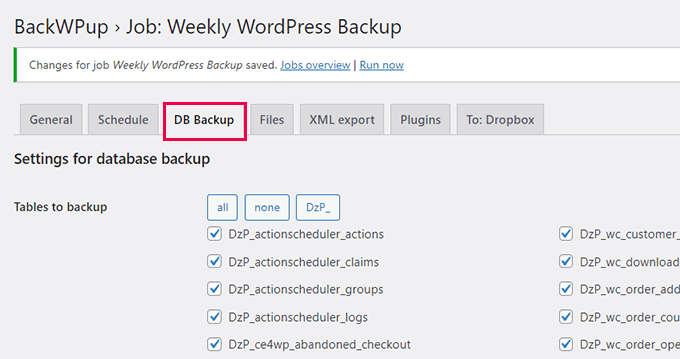
Haz clic en el botón “Guardar cambios” para establecer los ajustes.
A continuación, vaya a la pestaña “Archivos”. Desde aquí, puedes elegir qué archivos excluir de la copia de seguridad.
Si no está seguro, deje las opciones por defecto como están.
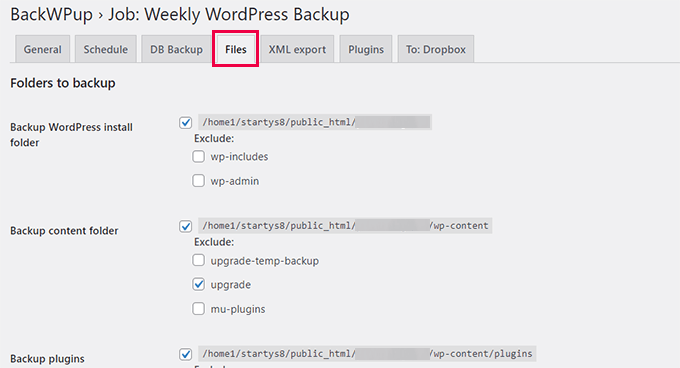
De nuevo, haz clic en el botón “Guardar cambios” para establecer los ajustes.
Ahora, tienes que cambiar a la pestaña “Exportar XML”. Desde aquí, puedes generar un archivo de exportación XML compatible con WordPress de todo tu contenido.
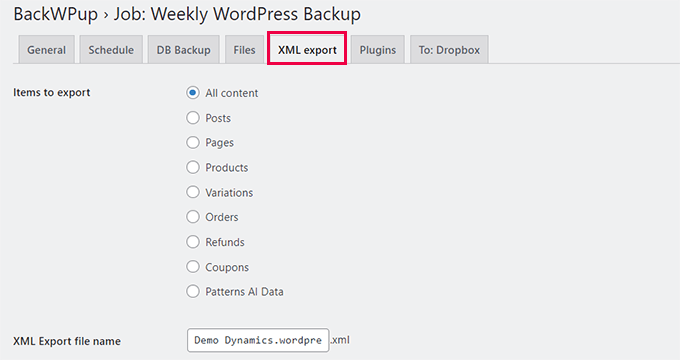
Las opciones por defecto funcionarán para la mayoría de los sitios web.
Guarda los cambios y pasa a la pestaña “Plugins”.
Aquí, la copia de seguridad plugin generará una lista de texto de todos los plugins instalados en su sitio web de WordPress.
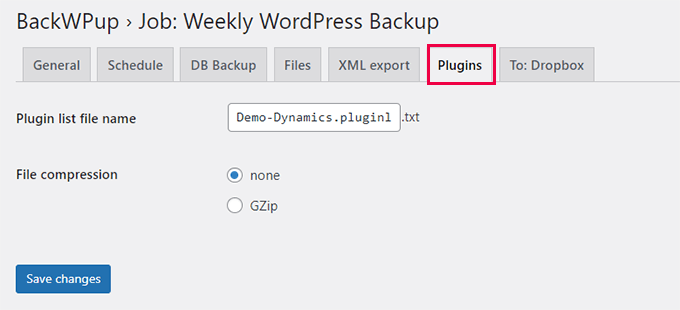
Por último, haz clic en el botón “Guardar cambios” para establecer los ajustes.
Paso 4: Ejecutar la copia de seguridad
Ahora que ha creado una tarea de copia de seguridad, debe ejecutarla por primera vez.
Vaya a la página de BackWPup ” Trabajos y haga clic en el enlace ‘Ejecutar ahora’ debajo del trabajo que creó anteriormente.
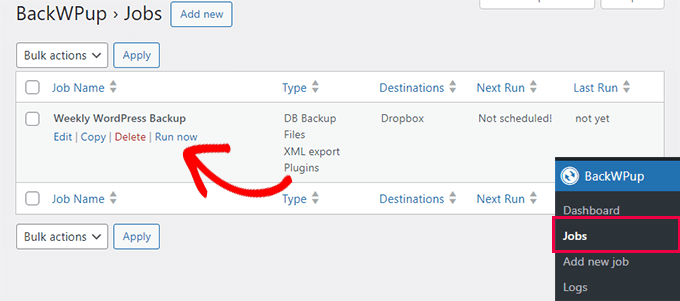
El plugin ejecutará la copia de seguridad y le mostrará el progreso.
Esto puede tardar un poco, dependiendo del tamaño de su sitio web. Una vez que haya terminado, verá un mensaje de correcto.
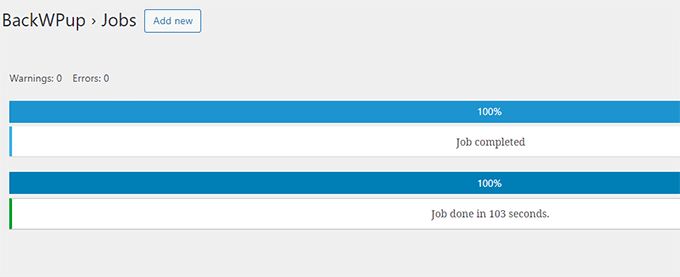
Ahora puede verificar el archivo de copia de seguridad visitando la fuente de destino (como Dropbox o la otra opción de almacenamiento que eligió anteriormente).
Cómo diagnosticar los trabajos de copia de seguridad de WordPress en BackWPup
Ejecutar un trabajo de copia de seguridad puede causar una carga extra en su servidor de alojamiento. Esto puede dar lugar a trabajos de copia de seguridad inacabados.
Además, en la mayoría de los servicios de alojamiento compartido, existe un límite de tiempo o memoria que puede consumir un script. Cuando su servidor detiene BackWPup por sobrepasar el límite de tiempo o memoria, espera un tiempo y luego reanuda el proceso. En este caso, tomará un tiempo para que el trabajo de copia de seguridad termine.
Lo primero que debe hacer para corregir esto es aumentar su límite de memoria PHP, luego vaya a BackWPup ” Ajustes y haga clic en la pestaña ‘Trabajos’.
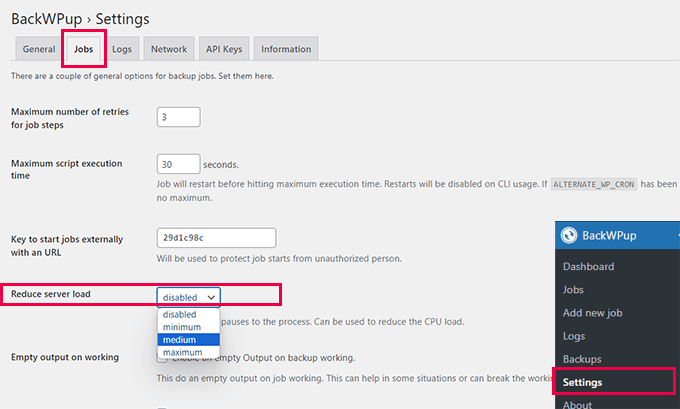
Aumenta la opción ‘Número máximo de reintentos para los pasos del trabajo’. El valor por defecto es 3, y puede aumentarlo a 5 y ver si esto funciona para usted.
A continuación, desplácese hasta la opción “Reducir la carga del servidor” y seleccione la opción “media” o “mínima”.
Por último, asegúrate de hacer clic en el botón “Guardar cambios” de la parte inferior para establecer los ajustes.
Restauración de su sitio web a partir de una copia de seguridad
Desafortunadamente, BackWPup no viene con una característica de restauración de 1 clic. Es por eso que tendrá que restaurar manualmente su sitio web desde diferentes archivos de copia de seguridad.
Para obtener instrucciones detalladas, consulte nuestro artículo acerca de cómo restaurar WordPress a partir de una copia de seguridad y siga las instrucciones de restauración manual de la base de datos y los archivos de WordPress.
Si desea un plugin de copia de seguridad de WordPress con una opción de restauración más sencilla, le recomendamos que utilice Duplicator. También hay una versión gratuita de Duplicator con menos opciones de copia de seguridad.
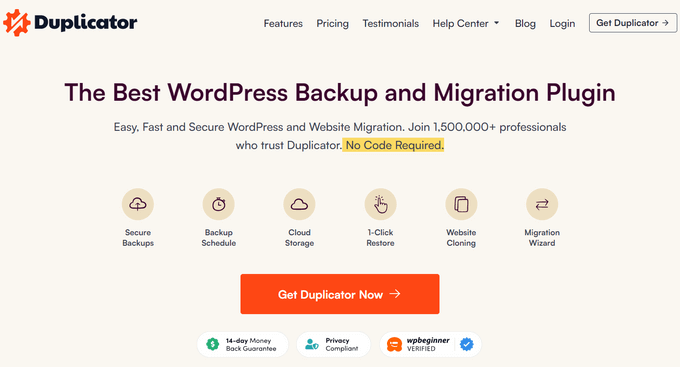
Para más información, puede consultar nuestra reseña / valoración completa de Duplicator.
Esperamos que este artículo te haya ayudado a crear una copia de seguridad completa de WordPress con BackWPup. Puede que también quieras ver nuestra guía de seguridad de WordPress para obtener más consejos para proteger tu sitio web o nuestra selección de expertos de los mejores plugins de seguridad de WordPress para proteger tu sitio.
If you liked this article, then please subscribe to our YouTube Channel for WordPress video tutorials. You can also find us on Twitter and Facebook.





Syed Balkhi says
Hey WPBeginner readers,
Did you know you can win exciting prizes by commenting on WPBeginner?
Every month, our top blog commenters will win HUGE rewards, including premium WordPress plugin licenses and cash prizes.
You can get more details about the contest from here.
Start sharing your thoughts below to stand a chance to win!
WPBeginner Staff says
1. The backups on your hosting service provider are sometimes not available. Also these backups could get compromised. Sometimes web hosting companies may even terminate your account without giving you enough time to get your files. In all these scenarios, and there are many others too, the user looses the access to their backup files.
2. Saving backups on the same server as your website actually defeats the purpose of backing up in the first place. For example, if the security of your server is compromised then your backup files could get affected too. This would make it immensely difficult for you to restore your website.
Michael Einstein says
OK.. I understand and this makes sense.. So would the WordPress Backup to Dropbox be a good option as an alternate place to store the backups, or perhaps to my google drive? Although I do worry a bit that these sites aren’t totally secure either. Only other option is if I can configure a backup to go to an external drive I have on my home computer that gets backed up everynight to a cloud-based backup.. That way I would have it on my home computer AND on the cloud. But this won’t work if my home computer is turned-off, although it is “usually on”.
Michael
Michael Einstein says
A few Newbie questions here:
1) If I use Bluehost for a hosted WordPress site, that comes with daily backups of my entire site. Why would I also need a seperate wordpress backup solution? Couldn’t I always just restore my site if anything ever happened through my cPANEL in Bluehost?
2) In this article, it says: “Whatever you do, DO NOT store the backups on your server.” Why? Isn’t this a good/secure place to store your backup since it also will get backed-up? Where else would I store it? Dropbox?? That actually sounds less safe and secure then in a dedicated directory somewhere on my hosting server.
Thanks for the help!
Regards,
Michael
Duncan McCormack says
It’s redundancy surely.
I think it’s a good idea to either use another backup technology (plugins) as well as your hosted provider method.
I also think it’s a good idea to download your hosted provider backups and put ‘em elswhere (on your work/home PC?) – but I’m happy to trust cloud technology providers, particularly Google and Microsoft. I reckon Dropbox are pretty trustworth too, eh? Surely.
WPBeginner Support says
Correct, it is mainly for redundancy and so you have control over your backups
Administrador
tealady46 says
I’ve followed the tutorial and am being told that it’s all backed up but when I’ve checked in my dropbox folder, I can’t see it. Any ideas??
Eloise says
There will be a separate BackWPup folder in your Dropbox – it’s not immediately obvious, so have a look around. Took me a couple of mins to find it when I first started doing using BackWPup too!
Bala Chandar says
I got an error like “The HTTP response test get an error “connect() timed out!”
Vitaliy Kolos says
OK, I’ve backed up my files, database, list of plugins, but now I’m sort of stuck because I’m not sure what I’m supposed to do next. I mean I know I’m supposed to restore certain files, but I’m afraid that I’ll override something that I actually need. Do I just leave wp-config.php alone and update the rest or what am I supposed to do next?
harishchouhan says
I have been using BackWPup since a while, but the “This APP will have access to your entire DropBox” scares me. With so many security issues being exploited every now and then, one wrong step, and I hope my DropBox data is not compromised.
Cypherinfo says
I did another copy and this again only the home page was showed; the other pages are redirected to the xampp setting http://localhost/xampp/ I tried to delete the .htaccess and every web page different from the home one report 404 error object not found; any advice? I’ve posted in the wrong place sorry. My comment is for this: https://www.wpbeginner.com/wp-tutorials/how-to-move-live-wordpress-site-to-local-server/
I’ve posted in the wrong place sorry. My comment is for this: https://www.wpbeginner.com/wp-tutorials/how-to-move-live-wordpress-site-to-local-server/
AV says
Dropbox is not active.. something is missing.. i installed this in local site.
WhyBother says
Thank you for this very detailed tutorial.
Abhishek Jain says
This is a real article to read about the v=backup of wordpress site… Thanks to author….
Alan Santana says
Does this backup saves all options, configurations, seo, etc.?
Or is there anything lost?
Somesh says
it stuck at
trying to create backup archive
WPBeginner Support says
Somesh, make sure your web host meets the minimum requirements to run the plugin. You would need PHP 5.2.6 at least. Also check out plugin’s FAQs section.
Administrador
Somesh says
Does it backup all the database files and all the stuff
Carole says
If you do a daily backups to Dropbox, do the files with changes replace the existing files or is a complete new backup added each day? My ecomm website seems to be 5GB so that could quickly blow through even 100GB of Dropbox storage.
Pali Madra says
As usual a great tutorial.
I did want to point out that in the first tab, which is called General, under the job details section the option to optimize database tables is not there anymore. Is this the case with me only or is it the same for everyone?
Thanks.
Aditya Shirodkar says
Thanks a lot for introducing me to this great plugin!… you guys are doing a great job!
E.D Gasçon says
Hey Syed, Thanks for sharing this info. This is a great article. I’m using Updraftplus backup/restore. I have a question please. This may sound silly… sending daily backups to the cloud (Dropbox) as opposed to weekly backups, would that take more storage space? If earlier versions of files are deleted then why am I running out of space so quickly? I’m not really adding much content to my sites (I’m not a blogger). I’m such a newb! Thanks
Alison Kirksey says
First, let me say that WPBeginner has been awesome to work with thus far and saved my bacon more than once as I navigate this tricky new world of WP.org.
I just followed this tutorial (I thought) to the letter. I keep getting a message that stops my back up. It says:
ERROR: Could not generate a WordPress export file
I’m such a newb, and don’t know what to do. What am I missing?
WPBeginner Support says
There could be several reasons for that. Please contact the plugin support thread for more help.
1. Incorrect file permissions on your WordPress site will prevent the plugin from storing the backup file.
2. Try changing the archive file type from zip to tar or tar.gzip
3. Try creating a new backup job using different settings.
Administrador
Vibeke says
Thanks for a very user-friendly tutorial. It worked well when installing the plugin and scheduling the back-up frequency, but I see now that the BackWPup menu item is no longer visible in my WordPress admin sidebar, and I cannot see any other place to edit the scheduled back-ups etc.
I would appreciate any help.
Many thanks in advance!
Vibeke
WPBeginner Support says
Vibeke make sure that plugin is activated by clicking on Plugins » Installed Plugins.
Administrador
Haseeb Ahmad Ayazi says
Hello Guys, Like Your Tut.. I Want you to give me a solution for my Network .. I am using MU and Want to store Media Files , Database and such other things to backup from the Network Admin Panel.
WPBeginner Support says
BackupBuddy and BackWPup has the capability to handle Multisite Network.
Administrador
Tarun Soni says
Thanks for this great article! this is great alternative of BackupBuddy,
Allie says
Hi and thanks so much for the great tutorial. I’ve installed BackWPup on your recommendation. My web designer set my blog up back in June and I’ve never backed it up. It’s been bugging me all along, I’m not so good with the techy stuff, and I didn’t know how to do it. This plugin seems really easy to use but unfortunately I’m running into problems. Every time I start a backup job, it gets stuck at 57%. I’ve clicked over to the php Memory Limit post you’ve linked to, but I am just not understanding… I can find the wp-config.php file in my c-panel, but when I click “edit,” I don’t see anything there with regard to memory limit. I’d be so grateful if you could spell it out for me, I am truly a beginner so please talk to me like I’m a first-grader! Thanks so much in advance
WPBeginner Support says
wp-config.php file is located in your website’s root directory. You can access it by using a web based “File manager” such as one located under Files in your cPanel dashboard. If you can not edit a file in the file manager, you can always download it to your computer and open it in a text editor like notepad. After that you can edit the file and upload it back to your website using the file manager.
Administrador
Darshan Gajara says
Does it works for WordPress.com sites as well?
WPBeginner Support says
No it does not. Please see the limitations of WordPress.com site and the difference between WordPress.com vs Self Hosted WordPress.org
Administrador
Nick says
Job destination only Backup to Folder & Backup sent by e-mail for me?
Only these two options! Any idea for that issue?
Thanks in advance!
WPBeginner Support says
We were unable to recreate the issue on a demo install. Please contact the plugin support.
Administrador
Nevis1 says
Any chance this works with Google Drive? They offer more free storage, and are cheaper in the long run. Thanks, very interesting post.
WPBeginner Support says
It does not support Google Drive at the moment.
Administrador
Mike says
Hi there, thanks for tutorial but as i use already this plugin, my question concerns its compatibility with Optimize Database after Deleting Revisions plugin. Can i use this one as well in complement to BackWPUP or does BackWPUP optimize as well ?
Thank you very much
BR
M
WPBeginner Support says
The plugin you mentioned deletes posts revisions stored in your database and optimizes it. We believe there is no reason these two plugins should have a conflict. However, if you create a backup before deleting post reivisions, BackWPup will obviously backup the post revisions which you are later going to delete. So when you restore your website those posts will be back. The solution to this problem is that you manually run BackWPUp after deleting your post revisions.
Administrador
Brittany Fichter says
Thank you for this article! I was wondering if I should delete old backup jobs to save space in my Dropbox (or if that’s even an option). Thanks again for the article!
Editorial Staff says
You can do that if you like. However just know that you can only go back as far as you have backups for
Administrador
Brittany Fichter says
Thank you for this article! I’ve only had my website up for a month, but I can’t imagine losing it! I was wondering if I should delete old backup jobs to save space in my Dropbox (or if that’s even an option). Thanks again for the article!
kalyan says
Your tutorial was immensely helpful , )
)
1. you helped me finalize one awesome plugin
2. It was a cakewalk after reading your tutorial (you didn’t miss a thing
3. you wrote a restore tutorial ( If in case )
just love your site . thank you .
Editorial Staff says
Thank you Kalyan.
Administrador
paul says
Ain’t BackUpWordPress plugin much simpler?
Maggie says
Thank you for the article. I followed your instructions step-by-step and it worked out easily! I have successfully backed up my blog to S3.
Just one more thing to curious about. During set up the back up job, you mentioned in the article that “We would recommend that you do not backup core WordPress files.”
Could you also explain why? Because I am totally new to WordPress, and I need to make sure I had my whole site backed up. I was feeling nervous to un-tick those boxes without understanding why to do it.
Naren P says
Because you can always download the latest version of wordpress core files in zip format through this website https://wordpress.org/download/. keep in mind, the “database” and the “wp-content” are the two most important part to be backed up on a regular basis. With your wp-content and database file, you can restore or even migrate your site to any hosting.
Ann Courtney says
Hi, can you tell me if this will backup galleries of photos on my site or only the Blog text?
Thanks for all your great ideas
Ann
Editorial Staff says
It backs up the photos as well.
Administrador
Jaime Jay says
Thanks so much for this article… I found it very useful… However, I did encounter some challenges with Dropbox, so I just used my FTP for the backup. Now, the challenge of actually finding the backup in my http://FTP... lol… thanks again!
Charlie Sasser says
Great tutorial! I’m currently using BackWPup but still picked up a few new things.
…however you said: “Whatever you do, DO NOT store the backups on your server.”
I understand why you are saying this but as long as the “one” stored on your own server is not the “only” backup, I actually think it is a good idea.
I have daily backups created and sent to Drop Box, Gmail, and one to a backup folder on the web server. It is a lot easier to use the one in the backup folder on the server if needed. If the whole web server crashes and burns and I lose the local backup, I still have the backups at Drop Box and Gmail.
If you store “a” copy on your web server, you need to make sure your backup is not backing up your backups by excluding that directory. Nothing like learning the hard way.
If I’m using Wordfence Plugin is the fact that BackupBuddy and VaultPress do malware scanning still of value?
Editorial Staff says
Charlie,
If you are storing backups on your server, then make sure those directories are protected. Because if someone gets their hands on the backup and download it, then your site can be compromised because they can use the database to find necessary information to login.
WordFence is nice, but we’d say that 2 layers of security is better than one
Administrador
Peter says
Charlie,
My CPanel host included anti-virus software that could manually check for a virus within directories, but it’s a waste of time as it won’t scan for a virus deliberately hidden within compressed backup files stored on the server usually created prior to downloading. So, when my site was hacked, the “shell program” of the virus/trojan, had been stored in the compressed backup “tar” file. When I downloaded it onto my computer it too failed to detect it, as did most popular Antivirus programs. So unless you know the host antivirus program works, it’s not worth relying on, I found that out the hard way too, the virus turned out to be a popular “PHP Trojan”, hard to find for the novice.One “free” program that actually found it without decompressing the “tar” file was Avast V7, but sadly the current version causes my SCSI based system to crash almost instantly, hence I reverted to MES, it doesn’t scan compressed files, but neither does it crash my system.
Tom Jamieson says
This is a great tutorial on how to use this plugin. Do you have any opinion on how it compares to the Backup to Dropbox plugin?
Karan Singh Chauhan says
Now if our site gets deleted or hacked, the how to restore it with using backup gz file.
Jesse Gardner says
This looks pretty interesting, I’ll have to give it a try!
Marc Connor says
Excellent article guys, great and easy instructions.
However, I must agree with Peter, the most crucial part of a backup is the restoration. No matter how nice and easy or fun the backup process of any tool is, if the restoration part of it is difficult and/or buggy, it’s a big bust.
Any thoughts, comments and/or other feedback on the restoration part of the BackWPUp plugin?
Sincerely,
Marc
Editorial Staff says
Marc that article is coming next
Administrador
Peter says
Exactly the point Marc, I agree, having backups are fine, I had several backup files compressed in an unfamiliar to me “tar” format (My host site did not give me a choice). It took some time to work out how to un-compress them, let alone how to transfer them back over to a compromised site and into their respective folders. Due to the frustration of not knowing how to do that, I gave up and totally rebuilt the site; luckily I copies of text and graphics files.
Since then I learned how to use the free File Transfer Program “FileZilla” to transfer files and directories onto my host site and overwrite existing files. Initially that was a nervous learning exercise, but I now do it regularly and reliably.
How many WP admins actually know how to backup and restore their sites in case of a major disaster? I had several backups, but did not know how to restore them successfully.
Sure there are affordable paid services out there, but for a simple hobby blog site, that may not be viable. The aim is to make a blog site or website as cheap as possible for the novice. However, once many hours have been spent setting up a website, how many sysops are actually willing to risk using a “Restore” function in a plugin program just to prove that it actually works when needed? I did not, and when it came to the crunch where I had no choice, it failed to work. Based on that experience, I would not try a “Restore” via Plugin unless I also knew how to do that manually in case the automated process failed.
There are viable alternatives, generally on the host site, but they all need to be mastered. My host used the popular CPanel hosting which has several programs capable of file transfer and backup, but the “restore process” is not as straight forward.
In my humble opinion, the ideal time to try to “restore a site” is when it has just been setup, with the minimum work spent on it, just in case it doesn’t work and one needs to start over. This site is aptly named WPbeginner hence restoring a crashed site is just as important as setting it up in the first place.
Editorial Staff says
Peter, this is why we wrote this article today:
https://www.wpbeginner.com/beginners-guide/beginners-guide-how-to-restore-wordpress-from-backup/
It shows you how to backup using various different methods including manually.
Administrador
Peter says
Thanks Editorial staff, had I known and tried out one of these methods before our site was hacked, it would have saved me many reconstruction hours.
I used FileZilla as described in your tutorial, but I was forced to learn that the hard way.
Sadly, most novices only do this after disaster has struck and are then forced to learn the hard way.
On another note, and if not already done, I would like to see an easy way of changing the font size and background colour or shading of blogs and replies in the twenty ten theme, e.g. blogs light blue with replies light green etc., but without resorting to program changes in the style sheets.
However, if that is the only practical way, then a detailed step by step tutorial on how to do that, without learning extensive programming, but including samples of typical results would also help.
Great site, keep it up.
Sidd says
The one service that always works in every scenario (but is not free) is VaultPress.
Where BackWPup(free), Snapshot by WPMU(premium) and inbuilt backups of ManageWP(premium) failed, only VaultPress passed.
Roy Hornsby says
Thanks for the article, currently I’m using WPB2D but after reading this I think I’ll try out BackWPup.
It would be useful to read a tutorial on how to restore WordPress from a backup. Is there one on WPBeginner?
cheers
Editorial Staff says
Roy that is next in the list to do. Expect it coming out either tomorrow or next week.
Administrador
Roy Hornsby says
ok thanks, I’m looking forward to reading it
cheers
emerhana says
please do a tutorial on the breadcrumb on wpbeginner.com
your toturial are always nice.
Editorial Staff says
We use a plugin called BreadCrumb NavXT
https://www.wpbeginner.com/blueprint/breadcrumb-navxt/
Administrador
Abhisek says
And yeah, you can style using “#the_breadcrumb { }” OR “.the_breadcrumb { }
Use this to display your breadcrumbs:
Mary says
Nice tutorial.
Editorial Staff says
Thanks Mary
-Syed
Administrador
Gerald Thulbourn says
All well and good if you can get BackWPup working. Past experience is that it dislikes running on many hosts and each update seems to bring in more problems, not fewer. Usually followed by a flury of bug fix subsequent updates. I live the idea, especially backup to drop box, but it just comes across as somewhat flaky.
Editorial Staff says
You are more than welcome to setup your S3 account and backup there. We showed Dropbox in the article due to its simplicity.
Administrador
Arsalan says
Nice article. I currently use WP Backup for this purpose but have found it to be limited in flexibility/functionality and have compatibility issues with newer versions of WordPress.
mary says
I read that this plugin needs PHP 5.2.6.
I have no understanding of what or where that is.
Also, are the drop boxes free as well? Thanks Mary
Editorial Staff says
Mary, Dropbox is free up until a certain point. After that you have to pay. PHP 5.2.6 is something that your host will have to answer. It is just the version number of the script they have installed.
Administrador
Mary says
Hey, Thank you for that information! I really like the idea of storing information away from my computer and the server.
Great articles!!! Best wishes!!!!Mary
David says
Nice to discover this. Sometimes a good plugin and go undetectable from the WP plugin search box. This one looks like it will meet my needs. Thanks, guys.
Editorial Staff says
You are welcome David
Administrador
Peter says
Great tutorial detailed and easily followed, unfortunately this is only half of what is needed.
Reliable “Restoring” is the crucial other half, a detailed tutorial (aimed at the novice) on how to do this, using the BackWPup files saved in Dropbox would be great, especially for a system that had been compromised. I spent many hours restoring my site, including using a plugin called UpdraftPlus-Backup/Restore created by David Anderson. When I needed to do a Restore it failed and just froze. Why I never found out, probably my fault, I still run it and allow it to generate backup files to Dropbox, just cannot seem to make the “Restore” part work.
However, since then I have learnt to use FileZilla FTP, that works every time and allows me to restore the site without problems including experimenting with different designs and trying out plugins, some that were found to be dodgy.
.
Sadly it took several hackers to crash my site and then for me to realise that some backup and restore plugins are just too unreliable or too difficult for me to use with confidence.
Thanks for WP, great program, used it since 2009, currently using the “twenty ten theme”.
Editorial Staff says
Hey Peter,
Reliable storing comes at a price. If you notice that VaultPress has a $5/mo. plan, and it is hassle-free. In order for you to setup a S3 environment and do all that, it would take time and money after a certain point. BackupBuddy has Stash which aims to ease things up, but again its a paid plugin.
Administrador
Daniel Chisu says
thanks for this free plugin. I am new with Word Press and I am just building my blog/website and I was wondering how can I backup accordingly.
So this newsletter came at the perfect moment and actually all the tutorials are great indeed!
Many thanks!
Editorial Staff says
It’s a pleasure to help Daniel
Administrador
t sambasivarao says
Great Info Thank you for Sharing….
Thank you for Sharing….
Manuel says
Thanks for this great article!
It’s great to see how much you like our Plugin
I just want to add the point that there is also a BackWPup Pro version in our market. With premium support and of course additional features like differential backup of changed directories to Dropbox, S3… and many more.
And how Syed mentioned: “The most important backup is the one that has never been made!”
Cheers,
Manuel
http://marketpress.com/product/backwpup-pro
Editorial Staff says
I thought about mentioning the paid version but felt that it didn’t offer enough (i.e malware scanning etc) which is big if you are going paid.
Administrador